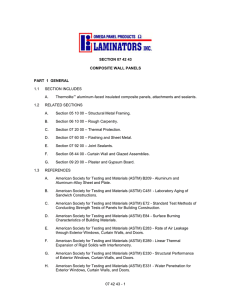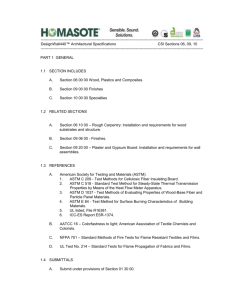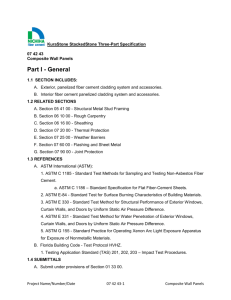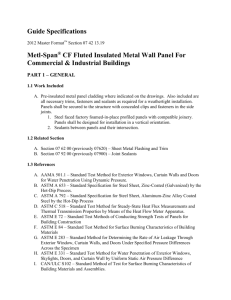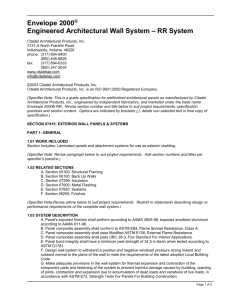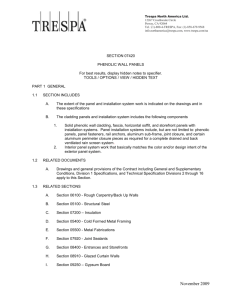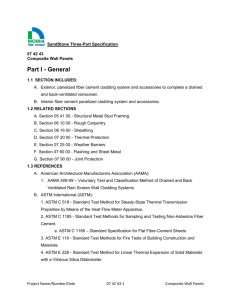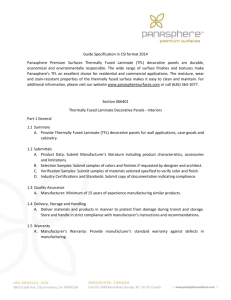Interactive Omega Foam-Ply Specification
advertisement
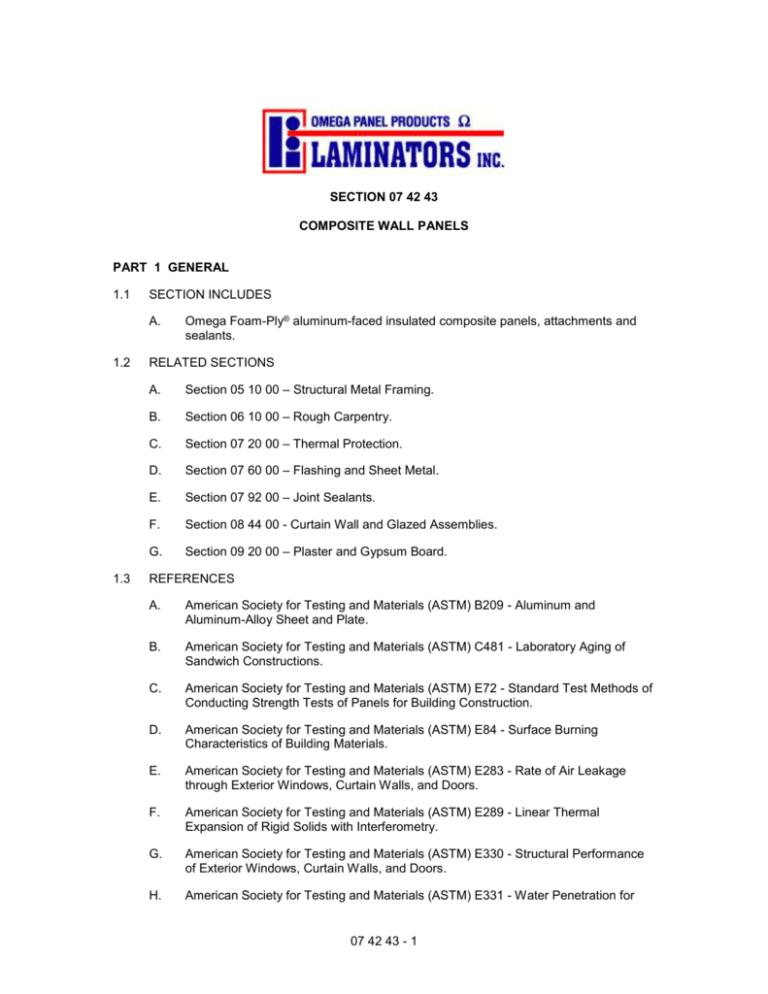
SECTION 07 42 43 COMPOSITE WALL PANELS PART 1 GENERAL 1.1 SECTION INCLUDES A. 1.2 1.3 Omega Foam-Ply® aluminum-faced insulated composite panels, attachments and sealants. RELATED SECTIONS A. Section 05 10 00 – Structural Metal Framing. B. Section 06 10 00 – Rough Carpentry. C. Section 07 20 00 – Thermal Protection. D. Section 07 60 00 – Flashing and Sheet Metal. E. Section 07 92 00 – Joint Sealants. F. Section 08 44 00 - Curtain Wall and Glazed Assemblies. G. Section 09 20 00 – Plaster and Gypsum Board. REFERENCES A. American Society for Testing and Materials (ASTM) B209 - Aluminum and Aluminum-Alloy Sheet and Plate. B. American Society for Testing and Materials (ASTM) C481 - Laboratory Aging of Sandwich Constructions. C. American Society for Testing and Materials (ASTM) E72 - Standard Test Methods of Conducting Strength Tests of Panels for Building Construction. D. American Society for Testing and Materials (ASTM) E84 - Surface Burning Characteristics of Building Materials. E. American Society for Testing and Materials (ASTM) E283 - Rate of Air Leakage through Exterior Windows, Curtain Walls, and Doors. F. American Society for Testing and Materials (ASTM) E289 - Linear Thermal Expansion of Rigid Solids with Interferometry. G. American Society for Testing and Materials (ASTM) E330 - Structural Performance of Exterior Windows, Curtain Walls, and Doors. H. American Society for Testing and Materials (ASTM) E331 - Water Penetration for 07 42 43 - 1 Exterior Windows, Curtain Walls, and Doors. 1.4 1.5 I. American Society for Testing and Materials (ASTM) D1781 - Climbing Drum Peel for Adhesives. J. American Society for Testing and Materials (ASTM) - Structural Performance of Exterior Windows, Curtain Walls, and Doors by Uniform Static Air Pressure Difference. K. American Architectural Manufacturers Association (AAMA) 501 – Water Penetration using Dynamic Pressure. L. American Architectural Manufacturers Association (AAMA) 605.2 - Voluntary Specification for High Performance Organic Coatings on Architectural Extrusions and Panels. M. American Architectural Manufacturers Association (AAMA) TIR-a11 - Maximum Allowable Deflection of Framing Systems for Building Cladding Components at Design Wind Loads. SYSTEM DESCRIPTION A. Design Requirements: 1. Design system to accommodate movement of components without buckling, failure of joint seals, undue stress on fasteners, or other detrimental effects when subjected to temperature and humidity ranges reasonably anticipated. 2. Design system to accommodate tolerances of structure. B. Performance Requirements: 1. Submit test data witnessed by an independent testing agency for the following requirements: a. Structural tests for wind loads by "Chamber Method" in compliance with ASTM E72. 1) Standard test design loading: 20 psf (960 Pa) positive and negative wind load. 2) Design panel system to withstand code imposed design loads and a deflection limit of L/180 shall apply to positive load pressures only. 3) Design panel system to withstand code imposed design loads and a deflection limit of L/175 shall apply to positive load pressures only. b. Air Infiltration: 0.06 cfm per square foot (32 lps per square meter) air leakage under a static pressure of 1.56 psf (7.65 kg per square meter) when tested in accordance with ASTM E283. c. Water Penetration: No uncontrolled water penetration through the standard vertical panel and sealed joints at a static pressure of 6.24 psf (30.5 kg per square meter) when tested in accordance with ASTM E331. SUBMITTALS A. Submit under provisions of Section 01 30 00. B. Manufacturer's data sheets on each product to be used, including: 1. Preparation instructions and recommendations. 2. Storage and handling requirements and recommendations. 3. Installation methods. 07 42 43 - 2 1.6 1.7 1.8 C. Shop Drawings: Submit shop drawings showing layout, flashings, drainage, ventilation, vapor barriers, vapor retarders, profiles and product components, including anchorage, accessories, finish colors, patterns and textures. D. Selection Samples: For each finish product specified, two complete sets of color chips representing manufacturer's full range of available colors and patterns. E. Verification Samples: For each finish product specified, two samples, minimum size 3 inches (76 mm) by 5 inches (128 mm) representing actual product, color, and patterns. F. Quality Assurance Submittals: Submit the following: 1. Test reports: Certified test reports showing compliance with specified performance characteristics and physical properties. 2. Certificates: Product certificates signed by manufacturer certifying materials comply with specified performance characteristics and criteria, and physical requirements. QUALITY ASSURANCE A. Manufacturer Qualifications: Manufacturer capable of providing field service representation during construction, approving acceptable installer and approving application method. B. Installer Qualifications: 1. Installer experienced in performing work of this section who has specialized in installation of work similar to that required for this project. 2. Panel Installer shall assume responsibility for all components of the exterior panel system including, but not limited to attachment to sub-construction, panel to panel joinery, panel to dissimilar material joinery, and joint seal associated with the panel system. C. Pre-installation Meetings: Conduct pre-installation meeting to verify project requirements, substrate conditions, manufacturer's installation instructions, and manufacturer's warranty requirements. DELIVERY, STORAGE, AND HANDLING A. Store panels horizontally, off-the-ground, in manufacturer's unopened packaging until ready for installation. B. Examine delivered materials upon receipt to insure that no damage has occurred during shipment. Store metal-faced composite wall panels horizontally, covered with a suitable weather tight and ventilated covering. Store metal-faced composite wall panels to ensure dryness, with a positive slope for drainage of water. Do not store metal-faced composite wall panels in contact with other materials that might cause staining, denting, or other surface damage. DO NOT allow storage space to exceed 120 degrees F (49 degrees C). C. Store and dispose of solvent-based materials, and materials used with solventbased materials, in accordance with requirements of local authorities having jurisdiction. PROJECT CONDITIONS A. Maintain environmental conditions (temperature, humidity, and ventilation) within 07 42 43 - 3 limits recommended by manufacturer for optimum results. Do not install products under environmental conditions outside manufacturer's absolute limits. 1.9 WARRANTY A. Finish Warranty: Commencing on Date of Substantial Completion. 1. Provide 20-year written warranty with PVDF/KYNAR 500 finish color coated metal finish covering color fading, chalking, and film integrity. 2. Provide 10-year written warranty with Polyester finish color coated metal finish covering color fading, chalking, and film integrity. 3. Provide 5-year written warranty with Anodized finish color coated metal finish covering color fading, chalking, and film integrity. 4. Finish coating shall not peel, blister, chip, crack or check. 5. Chalking, fading or erosion of finish measured by the following tests: a. Finish coating shall not chalk in excess of 8 numerical ratings when measured in accordance with ASTM D659. b. Finish coating shall not change color or fade in excess of 8 NBS units as determined by ASTM D2244. B. Material and Installation Warranty: Commencing on Date of Substantial Completion. 1. When installed as directed by Laminators Incorporated, panels covered by this warranty are warranted not to delaminate (separate) at any Laminators produced glue line for a period of five years. PART 2 PRODUCTS 2.1 2.2 MANUFACTURERS A. Acceptable Manufacturer: Laminators Incorporated; 3255 Penn St., Hatfield, PA 19440. ASD. Tel: (215)723-8107. Toll Free: (877) OMEGA77. Fax: (215) 721-1239. Shawn.crouthamel@laminatorsinc.com. Web: http://www.laminatorsinc.com B. Substitutions: Not permitted. C. Requests for substitutions will be considered in accordance with provisions of Section 01 60 00. OMEGA FOAM-PLY ALUMINUM-FACED INSULATED COMPOSITE PANELS A. 2.3 Omega Foam-Ply Insulated Composite Panels as manufactured by Laminators Incorporated. 1. Panel Construction: Prefinished ASTM B209 aluminum sheets over a corrugated polyallomer (CPA) stabilizers on both faces with an insulating foam core. 2. Panel Facing: Choose an item. 3. Panel Backing: Choose an item. 4. Panel Thickness: Choose an item. 5. Panel Core: Choose an item. 6. Fire Test Performance: ASTM E84: Class A. 7. Bond Test Performance: ASTM C481-A Cyclic Aging: Pass. 8. Finish: Choose an item. 9. Finish Colors: Click here to enter text. ACCESSORIES A. Manufacturer's Sealants and Accessories: Provide manufacturer's recommended 07 42 43 - 4 sealants and accessories for product installation. B. 2.4 Flashing: Fabricate flashing materials from 0.030 inch (0.76 mm) minimum thickness aluminum sheet painted to match the adjacent curtain wall/panel system where exposed. Provide a 12 inch (305 mm) wide lap strap under the flashing at abutted conditions and seal lapped surfaces with a full bed of non-hardening sealant. FABRICATION A. Panels shall be fabricated and finished as required to provide material construction and performance as specified and as required by manufacturer to comply with warranty provisions. 1. Tolerances: Length and Width: plus or minus 1/16 inch (1.6mm). Squareness (Diagonals): equal within 1/8 inch (3.2mm). PART 3 EXECUTION 3.1 3.2 EXAMINATION A. Do not begin installation until substrates have been properly prepared. B. Examine substrates, areas, and conditions, with substrate installer present, for compliance with requirements for structural soundness, installation tolerances, metal panel supports, and other conditions affecting performance of work. 1. Examine primary and secondary wall framing to verify that girts, angles, channels, studs, and other structural panel support members and anchorage have been installed within alignment tolerances listed below. a. 1/4 inch (6 mm) in any 20 feet (6 m) length vertically or horizontally. b. 1/2 inch (12 mm) in any building elevation. 2. Examine solid wall sheathing to verify that sheathing joints are supported by framing or blocking and that installation is within flatness tolerances required. 3. For the record, prepare written report, endorsed by panel installer and substrate installer, listing remedy for conditions detrimental to performance of work. C. Examine roughing-in for components and systems penetrating metal panels to verify actual locations of penetrations relative to seam locations of metal panels before metal panel installation. D. Proceed with installation only after all unsatisfactory conditions have been corrected. E. If substrate preparation is the responsibility of another installer, notify Architect of unsatisfactory preparation before proceeding. INSTALLATION A. Comply with manufacturer's installation guides and [ Product Data ], including product technical bulletins, product catalog installation instructions, and product carton instructions for installation type selected. B. Work shall be done and completed in a thorough and workmanlike manner by mechanics skilled in their various trades. C. Caulk Installation: 1. Use only approved sealants as described in Laminators Incorporated Installation Guidelines. 2. The sealant manufacturer’s instructions shall be followed in preparing and 07 42 43 - 5 3. 4. 3.3 FIELD QUALITY CONTROL A. 3.4 installing sealants. Joints to receive sealant shall be clean, dry and free from dust, grit and contaminants. The sealant shall completely fill the glazing pockets. Manufacturer's Field Services: Upon Owner's request, provide manufacturer's field service consisting of product use recommendations and periodic site visit for inspection of product installation in accordance with manufacturer's instructions. CLEANING AND PROTECTION A. Protection: Protect installed product and finish surfaces from damage during construction. B. Cleaning: Remove temporary coverings and protection of adjacent work areas. Repair or replace damaged installed products. Clean installed products in accordance with manufacturer's instructions prior to owner's acceptance. Remove construction debris from project site and legally dispose of debris. C. Protect installed products until completion of project. D. Touch-up, repair or replace damaged products before Substantial Completion. END OF SECTION 07 42 43 - 6
